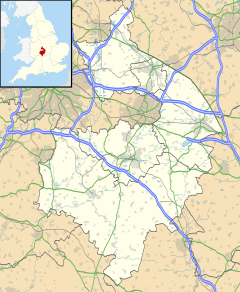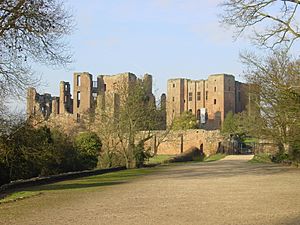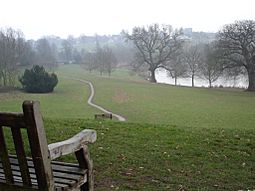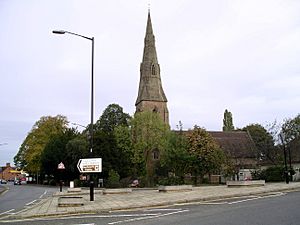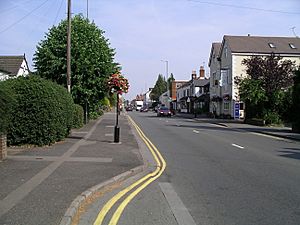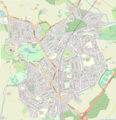Kenilworth facts for kids
Quick facts for kids Kenilworth |
|
|---|---|
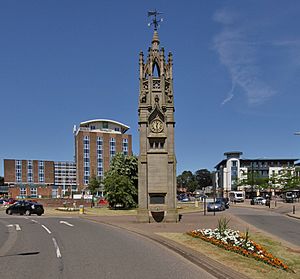 Clock tower at the junction of The Square, Smalley Place and Abbey End |
|
| Population | 22,413 (2011 Census) |
| OS grid reference | SP2971 |
| Civil parish |
|
| District |
|
| Shire county | |
| Region | |
| Country | England |
| Sovereign state | United Kingdom |
| Post town | Kenilworth |
| Postcode district | CV8 |
| Dialling code | 01926 |
| Police | Warwickshire |
| Fire | Warwickshire |
| Ambulance | West Midlands |
| EU Parliament | West Midlands |
| UK Parliament |
|
| Website | https://www.kenilworthweb.co.uk/ |
Kenilworth ( ken-IL-wərth) is a market town and civil parish in the Warwick District in Warwickshire, England, 6 miles (10 km) south-west of Coventry, 5 miles (8 km) north of Warwick and 90 miles (140 km) north-west of London. It lies on Finham Brook, a tributary of the River Sowe, which joins the River Avon 2 miles (3 km) north-east of the town. At the 2011 Census, the population was 22,413. The town is home to the ruins of Kenilworth Castle and Kenilworth Abbey.
Contents
History
A settlement existed at Kenilworth by the time of the Domesday Book of 1086, which records it as Chinewrde meaning "farm of a woman named Cynehild".
Geoffrey de Clinton (d. 1134) initiated the building of an Augustinian priory in 1122, at the same time as he initiated the building of Kenilworth Castle. The priory was raised to the rank of abbey in 1450 and suppressed in the Dissolution of the Monasteries in the 1530s. Thereafter the abbey grounds next to the castle, were made common land in exchange for common land that Robert Dudley, 1st Earl of Leicester used to enlarge the castle. Only a few walls and a storage barn of the original abbey survive.
Just off Coventry Road in Kenilworth is a field called the Parliament Piece. It is traditionally said to be the site where Henry III held a Parliament in August 1266, while his troops besieged Kenilworth Castle, where the late Simon de Montfort's followers, led by Henry de Hastings, were still holding out against the king's forces. This Parliament led to the Dictum of Kenilworth: a settlement that offered the rebels a way of recovering the lands that the Crown had seized from them. One copy of the Dictum is endorsed in castris apud Kenilworth — "in the camp (or castle) at Kenilworth". Members of the public have free access to Parliament Piece, which is owned by the Open Spaces Society and leased to Warwick District Council.
Geoffrey de Clinton had a deer park created near Kenilworth. In 1488 Ralph, abbot of Kenilworth Abbey had 40 acres (16 ha) of land near Redfern northwest of the town emparked as Duck Park, which despite its name was a deer park. By about 1540 there were eight deer parks near Kenilworth. Two were near Rudfen: as well as Duck Park there was a 30-acre (12 ha) park that was called Little Park in 1581, was owned by Robert Briscoe in 1649 and was still called Briscoe's Park in 1785. One of the eight deer parks, The Chase, can still be traced. The eastern part of its park pale is about 1 mile (1.6 km) west of the castle and the northern part forms the boundary between Chase Wood and the farm road and bridleway between Little Chase Farm and Warrior's Lodge Farm.
In about 1414 Henry V had le plesans en marais — "The Pleasuance in the Marsh" — built about 0.5 miles (800 m) west of the castle. This was a timber-framed banqueting house surrounded by a moated earthwork about 600 feet (180 m) by about 500 feet (150 m) that 15th century kings used instead of the castle's state apartments. In the 16th century Henry VIII had the banqueting house demolished and the materials re-used for new timber-framed buildings inside the castle. The mere was drained in 1649 but "The Pleasance" earthworks survive and are a Scheduled Monument.
Elizabeth I visited Robert Dudley, 1st Earl of Leicester at Kenilworth Castle several times, the last of which was in 1575. Dudley entertained the Queen with pageants and banquets that cost some £1,000 per day, presenting diversions and pageants surpassing anything ever before seen in England. These included fireworks.
Warwick District Council owns and manages land across the Coventry Road at Tainter's Hill. This area of public open space was designated "for the poor of the parish" under an inclosure act in 1756 and is now registered as common land. Around this time in 1778 Kenilworth windmill was built, which was later made the town's water tower. It is now a private home, minus its sails.
In 1844 the London and Birmingham Railway opened the Coventry to Leamington Line, including Kenilworth railway station. The L&NWR had a new station built in 1883 and a new link line between Kenilworth and Berkswell in 1884 to bypass Coventry. In the latter part of the 20th century British Railways closed the link line and had it dismantled.
BR withdrew passenger services from the Coventry to Leamington Line and closed Kenilworth station in January 1965 in accordance with The Reshaping of British Railways report. In May 1977 BR reinstated passenger services but did not reopen Kenilworth station, which fell into dereliction and was eventually demolished. In 2011 Warwick Council granted John Laing plc planning permission to build a new station, which was planned to open in 2013. This has now been postponed by three years to December 2016. In the meantime Kenilworth remains "the largest town in the country without a railway station" according to a BBC Radio 4 programme broadcast in October 2012, although this is a dubious claim as there are numerous candidates for this title among them Dudley and Washington with much larger populations. It is also hoped that a new station will coincide with the re-doubling of the track from Leamington Spa to Coventry.
The railway brought industrialists from Birmingham and Coventry who developed the residential area around the town's railway station. In the 19th century the town had some fine large mansions with landscaped gardens; these were demolished after the First World War and Second World War for housing developments. The names of these mansions still survive in the names of some roads and areas of the town. For example, Towers Close was built on the grounds of Rouncil Towers. Some large trees from their grounds still survive, including Giant Sequoias from the Moorlands and Rouncil Towers.
The town's growth occasioned the addition of a second Church of England parish church, St. John's, which is on Warwick Road in Knights Meadow. It was designed by Ewan Christian and built in 1851–52. It is a Gothic Revival building with a southwest bell tower and broach spire.
After 1883 the original 1844 railway station on Warwick Road was partially rebuilt at the opposite end of Station Road at the rear of the King's Arms and Castle Hotel public house and used as a cafe. The King's Arms was demolished in 1983 but the railway station stonework remains. An exterior copy of the King's Arms was built on the site, in 2007 the building was redeveloped as a chain restaurant. The building's distinctive pillars have been retained (but not the originals) on its Warwick Road frontage. Sir Walter Scott stayed in the King's Arms and Castle Hotel when researching his novel Kenilworth.
In 1884 St Nicholas' Parish Church established a mission room in an upstairs room above the Co-Op in Park Road. It attracted a congregation of 150 people and in 1885 moved to new premises. In 1905 the congregation moved to a new "tin tabernacle" iron building that had been newly erected in Albion Street and consecrated as Saint Barnabas' Mission Church, a daughter church of St. Nicholas'.
The railway boosted Kenilworth's market gardening.
The former mansion on Forrest Road, built around 1901, still stands. It is believed that a William Forrest bought the surrounding land, except that of the terrace to the north of Abbey End, and built the house, either for himself or for his family. The house was split into three separate residential lots in the 1970s, the main part of the house forming 'Hillcrest', the west wing of the house with the main grand staircase and gardens forming 'Max Gate', and the billiards room forming the bungalow 'South Brent'. The former landscaped gardens to the east and west of the property have been built on for residential purposes, but the south and north gardens still belong to the house. Some main features have been lost during the transition internally, but externally the house still keeps its grand bay windows, tiled walls, high chimney stacks and other features, which can be seen in the new flats, Mulberry Court on Abbey End. Warwick Road is now the main commercial centre of the town
Most of the older existing buildings of Kenilworth are on Castle Green, New Row and High Street (formerly Alta Strata, meaning the high dry ground above the Abbey
In May 1961, the Kenilworth Society was formed as a result of concerns about a group of 17th century listed cottages adjacent to the Finham Brook in Bridge Street. The Society's objectives are to promote consciousness about Kenilworth's character and to encourage its preservation.
Modern Kenilworth
Modern Kenilworth has been described as a dormitory town for commuters to Coventry as well as Birmingham and Leamington Spa. Despite its proximity to the University of Warwick at Gibbet Hill in Coventry, it has only a small student population of mostly postgraduate students, although many staff at the university choose to live in Kenilworth.
In 2008, Waitrose opened a supermarket in Kenilworth and hardware chain Robert Dyas opened a 'new format' store in November 2011. There are also plans to renovate the existing public library buildings. The town's old youth centre was demolished in 2007 to make way for the new supermarket, and a new one was built.
Kenilworth is home to The Cross, a pub restaurant which received a Michelin star in 2014.
Since 2010, Kenilworth has been part of the Kenilworth and Southam constituency.
In the centre of Kenilworth stands a Kugel ball water feature, called the Millennium Globe.
Districts
Districts within the town include Abbey End, Burton Green, Castle End, Crackley, Knight's Meadow, Ladyes Hill, St John's, Whitemoor and Windy Arbour.
Transport
The A46 bypass opened in June 1974. Both Birmingham Airport and the M6, M42 and M40 motorways are within 12 miles (19 km) of the town. The railway station at Kenilworth is on the Coventry to Leamington Spa line, it was closed in 1965 and reopened in April 2018. it has direct services operated by West Midlands Trains to Nuneaton, Coventry and Leamington Spa. Warwick Parkway station is 11–14 minutes' drive away.
Arts
Theatres
The Talisman Theatre was founded as the Talisman Players in 1942 and moved to its current 156-seat auditorium in Barrow Road in 1969. It was awarded eight NODA awards between 2004 and 2014.
The Priory Theatre was founded in 1932 as the Kenilworth Players. Kenilworth's former Unitarian chapel, a Perpendicular Gothic Revival building dating from 1816 was converted into a 119-seat theatre building for the company in 1945–46. It was gutted by fire in 1976 but was restored and in September 1978 was reopened.
Kenilworth Festival
In 2005, the Kenilworth Festival was revived after a 70-year interval. The first year was a big success but attendance was lower in 2006, doubts were raised about the festival's longevity and no festival was held in 2007. Kenilworth Rotary Club then sponsored a revival of the festival in 2008, since when it has continued each year. In 2011, the festival lasted for a whole week including two weekends, 7 to 15 May.
Famous people
In order of birth:
- Henry III of England (1207–1272) commissioned the Dictum of Kenilworth, which was made public on 31 October 1266.
- Edward II of England (1284–1327) was held prisoner in Kenilworth Castle in 1326–27.
- Robert Dudley, 1st Earl of Leicester (1532 or 1533 – 1588) lived at Kenilworth Castle.
- Thomas Underhill (1545–1591) was keeper of the wardrobe at Kenilworth Castle.
- Thomas Hearne (1744–1817), landscape artist, painted The Priory Gate at Kenilworth in 1784.
- William Field (1768–1851), Unitarian minister and local historian, served the Old Meeting House at Kenilworth from about 1830 to 1850.
- Sir Walter Scott's (1771–1832) novel Kenilworth. A Romance appeared anonymously in 1821.
- Samuel Butler (1774–1839), classical scholar and bishop, became the incumbent of Kenilworth in 1802.
- John Sumner (1780–1862), archbishop of Canterbury, was born in Kenilworth.
- Charles Sumner (1790–1874), religious writer and bishop, was born in Kenilworth.
- William Gresley (1801–1876), religious writer and cleric, was born in Kenilworth.
- Samuel Hawksley Burbury (1831–1911), mathematician, was born in Kenilworth.
- Anna Russell (1807 – 1876), botanist, lived in Kenilworth.
- Isabel, Lady Burton (née Arundell, 1831–1896), religious writer and wife of the scholar Richard Francis Burton, was born in Kenilworth.
- George Potter (1832–1893), trade unionist, first president of the Trades Union Congress of England and Wales, was born in Kenilworth.
- Sir Arthur Sullivan's (1842–1900) long association with vocal music began with a cantata, The Masque at Kenilworth, in 1864.
- Jack Burns (1859–1927), Scottish champion golfer, was instrumental in creating in the Kenilworth course in 1890.
- Oliver Bodington (1859–1936), Paris-based international lawyer and marriage broker, was baptised in Kenilworth.
- Edith Emma Cooper (1862–1913), one half of Michael Field, poet, dramatist and diarist
- Edgar Jepson (1863–1938), writer of crime, adventure and fantasy novels, was born in Kenilworth.
- John Siddeley, Lord Kenilworth (1866–1953), motor and aero engineering pioneer, moved to Crackley Hall, Kenilworth, in 1918.
- Reginald Lee (1870–1913), surviving crew member of the wreck of RMS Titanic, died in Kenilworth.
- Walter Ritchie (1919–1991), sculptor, lived and worked in Kenilworth.
- Basil Heatley (born 1933 in Kenilworth), marathon runner and Olympic silver medallist.
- Andrew Davies (born 1936), is a Kenilworth-resident novelist and screenwriter (the 1995 BBC Pride and Prejudice).
- Julia Slingo (born 1950), climate scientist and Dame Commander of the Order of the British Empire, was born in Kenilworth.
- Peter Marlow (born 1952 in Kenilworth), news and topographical photographer.
- Tim Flowers (born 1967 in Kenilworth) was an Association Football goalkeeper for England (capped 11 times), Wolverhampton Wanderers and five other FA teams.
- Rebecca Probert (born 1973), legal historian and expert on marriage law, lives in Kenilworth with her travel-writer husband Liam D'Arcy Brown.
- Kelvin Langmead (born 1985), professional football player football (sport) for Kidderminster Harriers, was educated at Kenilworth School.
- Sarah-Jane Perry (born 1990), professional international squash player, was educated at Kenilworth School.
Town twinning
Kenilworth is twinned with:
 Bourg-la-Reine, Hauts-de-Seine, France
Bourg-la-Reine, Hauts-de-Seine, France Eppstein, Hesse, Germany.
Eppstein, Hesse, Germany.
Kenilworth has friendship links with:
 Bo, Sierra Leone, through One World Link (OWL)
Bo, Sierra Leone, through One World Link (OWL) Uyogo, Tanzania
Uyogo, Tanzania
Sport
Kenilworth Town FC, located in Gypsy Lane in the south of the town, played in the Midland Combination until June 2011, when it resigned, preferring to spend money on ground improvements rather than fielding a team. It re-entered the English football pyramid in the 2013–14 season and was placed in the Midland Football League Division 3, the 12th highest tier in the English league system. The stay, however, was brief; the first team again resigned shortly afterwards. The Gypsy Lane ground was purchased in 2018 by Coventry Plumbing F.C., which demolished the clubhouse and built a new one, before starting the 2019–20 season there. Kenilworth Wardens FC is based at Kenilworth Wardens, a Community Amateur Sports Club in Glasshouse Lane to the east of the town.
Kenilworth RFC is the town's rugby union club. It fields three senior sides and hosts a large minis, juniors and colts section. The ground is also located in Glasshouse Lane. Kenilworth Tennis, Squash and Croquet Club, in Crackley Lane, has nine tennis courts, five squash and racketball courts and two croquet lawns. Kenilworth has two cricket clubs: Kenilworth Wardens in Glasshouse Lane fields five senior teams and a juniors section starting from seven years old; Kenilworth Cricket Club fields three senior teams and plays at the Warwick Road ground. Kenilworth Runners meets at the Wardens. It caters for runners of all ages and abilities. Octavian Droobers is the local orienteering club, using maps of Abbey Fields and Kenilworth Common on which to stage events.
Kenilworth Wheelers meets all the year round on Saturday and Sunday morning for a road ride. During the summer months, regular evening training rides cater for all abilities from novice to racer. Abbey Fields Swimming Pool is in Abbey Fields. It has a 25 m by 10 m indoor pool and an outdoor pool open from May to September. It is home to Kenilworth Swimming Club and Kenilworth Masters Swimming Club. Kenilworth Golf Club features a mature 18-hole parkland course, plus a small six-hole par 3 course. Castle Farm Recreation Centre has a four-court badminton hall suitable for basketball, volleyball, netball, table tennis, short mat bowls and children's parties. It is available for use by the public and by sports clubs that make block bookings throughout the year.
Two Castles Run
The Two Castles Run began in 1983 as a fun run between Warwick Castle and Kenilworth Castle. It has grown into an English Athletics-licensed run with 3,000 entrants in 2010. In 2010 and 2011 it held the Warwickshire Amateur Athletic Association 10 Kilometre Championship. In 2012 all 4,000 places were sold within 25 hours. The race is organised each June by Kenilworth Rotary Club in conjunction with the Leamington Cycling and Athletic Club.
Education
The principal secondary school in Kenilworth is the Kenilworth School and Sixth Form, based at two different sites in the town. There are also a number of schools for primary age children.
Notable people
In order of birth:
- Henry III of England (1207–1272) commissioned the Dictum of Kenilworth, which was made public on 31 October 1266.
- Edward II of England (1284–1327) was held prisoner in Kenilworth Castle in 1326–1327.
- Robert Dudley, 1st Earl of Leicester (1532 or 1533–1588) lived at Kenilworth Castle.
- Thomas Underhill (1545–1591) was keeper of the wardrobe at Kenilworth Castle.
- Thomas Hearne (1744–1817), landscape artist, painted The Priory Gate at Kenilworth in 1784.
- William Field (1768–1851), Unitarian minister and local historian, served the Old Meeting House at Kenilworth from about 1830 to 1850.
- Sir Walter Scott's (1771–1832) novel Kenilworth. A Romance appeared anonymously in 1821.
- Samuel Butler (1774–1839), classical scholar and bishop, became the incumbent of Kenilworth in 1802.
- John Sumner (1780–1862), Archbishop of Canterbury, was born in Kenilworth.
- Charles Sumner (1790–1874), religious writer and bishop, was born in Kenilworth.
- William Gresley (1801–1876), religious writer and cleric, was born in Kenilworth.
- Samuel Carter MP (1805–1878), inherited property in Kenilworth and is buried in the graveyard of St Nicholas.
- Anna Russell (1807–1876), botanist, lived in Kenilworth.
- Samuel Hawksley Burbury (1831–1911), mathematician, was born in Kenilworth.
- Isabel, Lady Burton (née Arundell, 1831–1896), religious writer and wife of the scholar Richard Francis Burton, was born in Kenilworth.
- George Potter (1832–1893), trade unionist, first president of the Trades Union Congress of England and Wales, was born in Kenilworth.
- Sir Arthur Sullivan's (1842–1900) long association with vocal music began with a cantata, The Masque at Kenilworth, in 1864.
- Jack Burns (1859–1927), Scottish champion golfer, was instrumental in creating the Kenilworth course in 1890.
- Oliver Bodington (1859–1936), Paris-based international lawyer and marriage broker, was baptised in Kenilworth.
- Edith Emma Cooper (1862–1913) was one half of Michael Field, known as a poet, dramatist and diarist.
- John Siddeley, Lord Kenilworth (1866–1953), motor and aero engineering pioneer, moved to Crackley Hall, Kenilworth, in 1918.
- Reginald Lee (1870–1913), surviving crew member of the RMS Titanic, died in Kenilworth.
- Walter Ritchie (1919–1991), sculptor, lived and worked in Kenilworth.
- Basil Heatley (born 1933 in Kenilworth) was a marathon runner and Olympic silver medallist.
- Andrew Davies (born 1936), is novelist and screenwriter who lives in Kenilworth (the 1995 BBC Pride and Prejudice).
- Julia Slingo (born 1950), climate scientist and Dame Commander of the Order of the British Empire, was born in Kenilworth.
- Peter Marlow (1952–2016) was a photojournalist and photographer.
- Tim Flowers (born 1967 in Kenilworth) is an Association football goalkeeper, notably for Southampton and Blackburn Rovers. He was capped 11 times by England.
- Rebecca Probert (born 1973), legal historian and expert on marriage law, lives in Kenilworth with her travel-writer husband Liam D'Arcy Brown.
- Kelvin Langmead (born 1985), professional football player for Kidderminster Harriers, was educated at Kenilworth School.
- Sarah-Jane Perry (born 1990), professional international squash player, was educated at Kenilworth School.
Images for kids
-
The ruins of the gatehouse of Kenilworth Abbey
-
The parish church of St Nicholas, where Elizabeth I worshipped in 1575 and James I visited in 1616
See also
 In Spanish: Kenilworth para niños
In Spanish: Kenilworth para niños


